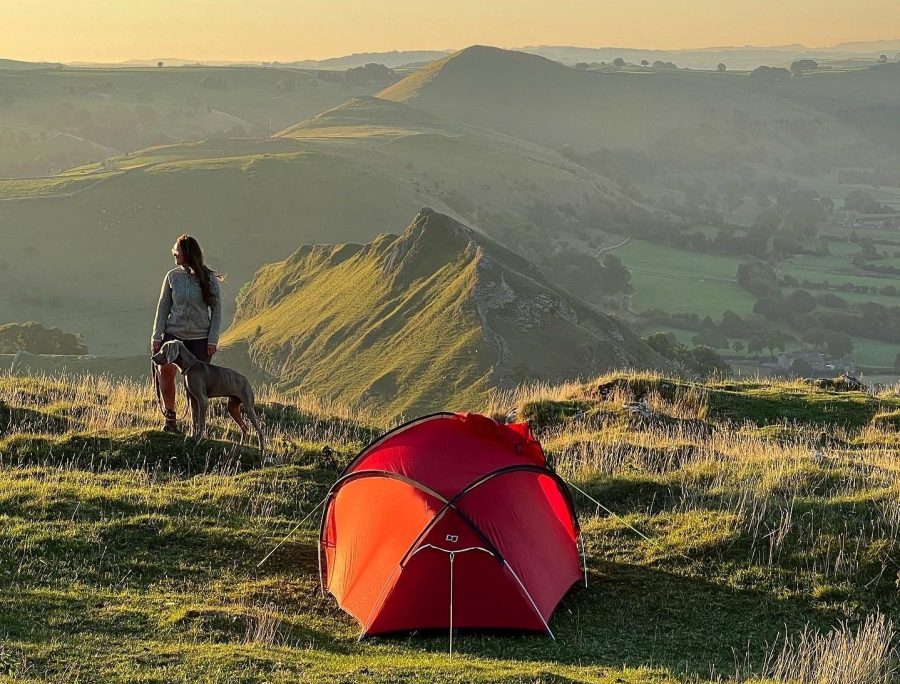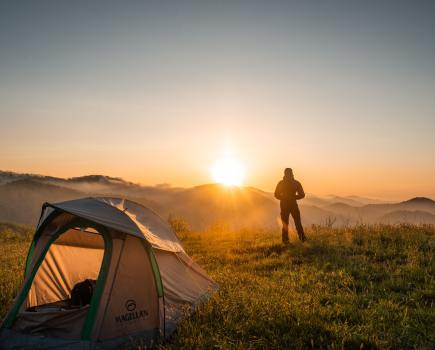Summer nights aren’t that cold in Britain. Even high in the hills, below-freezing temperatures are unlikely. But cool, damp nights are not uncommon and you still need an adequate sleeping bag to keep warm.
So, what exactly makes a good sleeping bag for summer conditions here in the UK? The Great Outdoors‘ outdoor gear expert Chris Townsend shares everything you need to know about sleeping bags for summer use, from unpacking temperature ratings to the synthetic or down debate.
Words: Chris Townsend | Main image: Francesca Donovan
How cold are British summer nights?
This varies enormously. High camps under clear skies will be much colder than low-level camps in cloudy weather. When I spent a summer walking over all the Munros and Tops (3000’ summits in Scotland) I camped almost every night and the lowest overnight temperature in June was 2°C, the highest 15°C, in July it was 5° and 17°, in August 6° and 16°. The average lows were 8° in June, 10° in July and 12° in August. This suggests that a bag in the 0° to 5° minimum range should be fine for most people. Warm sleepers can probably manage with one in the 5 to 10°C range.
Sleeping bag ratings
Rating sleeping bags is difficult as many variables are involved – how warm you sleep, how humid it is, how tired you are, when you last ate, how thick your mat is and more. Temperature ratings are helpful in comparing bags but how much someone feels the cold varies widely. I’m a warm sleeper and find bags rated to around 5°C warm enough for the coldest summer nights. I have companions who are cold in anything rated above freezing and generally prefer bags rated to -5°C or lower. See more on How sleeping bag ratings and temperatures work
Synthetic or Down?
Whilst the best synthetic fills are now very good, they are still heavier for the warmth, bulkier when packed and usually shorter-lived than down. The advantages of synthetics are lower initial cost, easier care and resistance to wetting. It’s often claimed that synthetic bags are warm when wet. They aren’t, but they will dry much faster than standard down and a little faster than hydrophobic down. No bag is comfortable when wet, whether down or synthetic. By using drybags it’s easy to keep a sleeping bag dry.
There are many types of synthetic fill, some of them own-label ones, which makes comparisons difficult. The weight and bulk are indicators of the quality of the fill, Heavy bags that don’t compress well usually have low quality fills.
It’s easier with down, which comes in different grades. This doesn’t affect the longevity but indicates the warmth a given weight will provide. The measurement for this is called the fill power, which is the volume in cubic inches an ounce (28.35 grams) of down will fill. The higher the fill power the higher quality of the down. Thus 750 fill power down will be warmer than the same weight of 600 fill power down.
Some down is hydrophobic, which means it doesn’t absorb as much moisture and it dries quicker than standard down. It doesn’t mean it’s waterproof. Whilst hydrophobic down may give some reassurance against damp I don’t think it’s significant in sleeping bags and I wouldn’t choose one sleeping bag over another because of it. I’ve used standard down bags for months at a time in wet places like the Scottish Highlands and never had a problem.
If you’re working to a budget then our guide to best budget sleeping bags will be useful for you.
Shape & Size
Whilst the fill is the most important factor the design and shape of a bag make a difference to the warmth as well. Most bags are tapered and have hoods. This mummy shape was designed for maximum warmth for mountaineering and polar exploration. For summer it’s not essential. A bag without a hood saves a little weight. There is the option of a quilt rather than a bag as well, which also saves weight. A quilt can be tucked under you for warmth and spread out if you feel hot.
Find out more about the different types of sleeping bag here.
Zip
A zip lets you ventilate a bag and makes getting in and out easier. Bags with full-length zips can also be used as quilts on very warm nights. Two-way side zips give the best heat control as you can open them a little way from the top or bottom – excellent if you suffer from hot feet! Centre zips are not quite as versatile as side zips for ventilation but do make getting in and out of the bag easier and can be opened slightly at the top when sitting up.
Now that you know what sleeping bag you can use for summer, why not check out our winter guide to sleeping bags, too.








